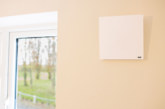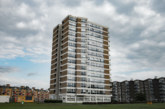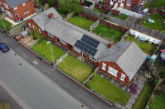The Energys Group LED upgrade at Leytonstone School is set to deliver £8.7K annual savings – as well as pupil wellbeing benefits. LABM finds out more.
Leytonstone School is on track to significantly reduce its annual energy use following the final part of its LED lighting upgrade — as financed by the London Borough of Waltham Forest’s Salix Fund. The project is estimated to achieve annual savings in the region of £8,700 against a project cost of £69,639. This is estimated to lead to carbon reduction savings of 24.61 tonnes of CO2/pa with a lifetime carbon savings of 615 tonnes. Return on investment is predicted to be within 7.3 years.
Leytonstone School has been in its current location in the London Borough of Waltham Forest for over a century. Today, more than 800 students aged between 11-16 attend the school, which has been rated as Good by OFSTED since 2016.
As one would expect, since Leytonstone School first opened, there has been ongoing development of the site. The latest refurbishment took place just four years ago when the lighting in the main building was upgraded to LED. However, the lighting in the Practical block and Music and Drama building was not upgraded at that time. Sean Goffin, Site Manager at the school, became increasingly concerned about the maintenance costs and levels of lighting failures, particularly relating to the emergency lighting. When he contacted Nimish Shah, Energy Manager at London Borough of Waltham Forest, he was confident that they would be keen to assist.

Salix funded solution
The London Borough of Waltham Forest supports schools in the Borough to improve their energy efficiency and reduce their carbon emissions through its Salix Fund. Waltham Forest match-funds the Salix grant to provide loans to schools within the borough. As Nimish Shah explains: “We loan funds to schools to invest in energy efficiency projects and they repay us as those savings are realised. We have been running this fund for the past decade and so far we have recycled it 2.5 times.”
With more than 50 maintained schools within the Borough, the team at Waltham Forest are keen to target schools with the highest expenditure on energy projects. This latest project for Leytonstone School showed significant scope to make further savings – and as such the Borough’s energy team agreed it was a project to proceed with.
Minimum disruption, maximum savings
Raj Gunasekaren, Business Development Manager at Energys Group proposed a solution to which could be delivered with minimum disruption. Self-learning Intelligent Wireless Control LED lights were installed, which use iDim Active+ sensor technology. This is an intelligent wireless automatic control that provides daylight harvesting and presence detection without need for re-wiring or modification to existing circuits.
Energys Group estimated that the project would take 10 days to complete and, in order to minimise disruption to the school timetable, the project was scheduled for the Summer half-term holiday. In the event, the majority of the project was completed during the half-term week and the team finished off the project by working a couple of early mornings and late evenings.
Improved quality of light
The school’s Site Manager Sean Goffin was very pleased with the way in which Energys Group delivered this project: “The work was completed on time and with minimum disruption to the school day and teachers have already commented on the improvement in the quality of the lighting, which is an excellent outcome.”
Sean is delighted with the commitment the Energys Group team has made to following up and tweaking the new system: “Nothing has been too much trouble for them and, whilst it is still early days in terms of seeing the energy savings coming through, I am already noticing a reduction in the maintenance time for the lighting in these two buildings.”
Raj Gunasekaran, Business Development Manager at Energys Group says: “We are delighted to install our energy efficient, state of the art LED technology at Leytonstone School. Staff and students alike will now benefit from all the known benefits of LED lighting, including reduced eyestrain and improved alertness — and the school budget benefits too.”

Lighting for pupil and teacher wellbeing
At Leytonstone School, LED technology is delivering above and beyond energy benefits. There are tangible wellbeing outcomes too. It is now widely accepted that LED lighting technologies have been proven to help deliver pupils — and teachers and other staff — the best light levels, to improve health and wellbeing and learning application.
‘Higher illumination levels lead to increased concentration,’ claims one study. Both natural light and modern LEDs can therefore dramatically benefit children’s happiness and intelligence.
‘Especially in education, a conscious mind is important for good concentration during lessons. It doesn’t matter if the person is an elementary scholar or a student. Both can benefit from an optimised lighting environment in a direct or indirect way,’ argues an EU-backed report on the benefits of lighting upgrades for schools.
Whilst natural light is always best, and always the most sustainable, where natural light is lacking, for example on dark days or in poorly designed legacy buildings, new lighting technology has a crucial role to play. In these circumstances, LED alternatives ensure that pupils have the best light levels, the right colour gradients and the cooler temperatures modern solutions provide.
The search for practical improvements to legacy lighting suggests schools should be appointing lighting providers that, first and foremost, understand the issues. This drive should come from the top down.
After all, both education and lighting are complex. The modern school features many competing drivers, performance standards and benchmarking measures. Among all these, it is easy for lighting to lose advantage. Management level guidance is required.
The challenge is plain. If school leaders overlook lighting improvements in the race to tick boxes, schools will miss easy opportunities to improve learning, results, happiness and day to day school life.
Ironically, these are the very metrics inspectors use to rate schools’ performance. The right lights will contribute across every facet of school life; sustainability, low carbon and productivity. In the competition for management time and funding, it’s never been more critical that lighting does not lose out.









